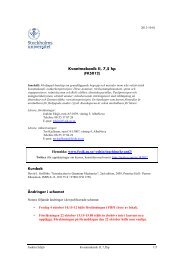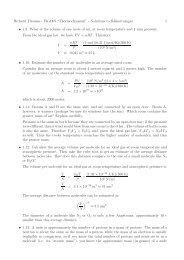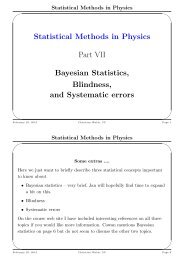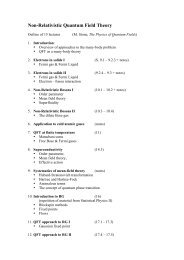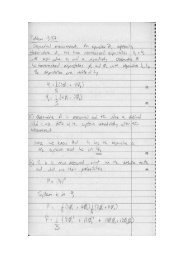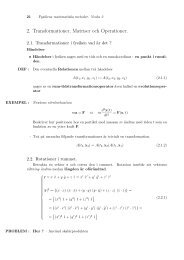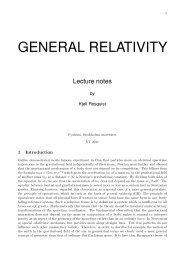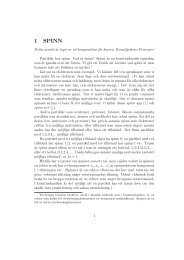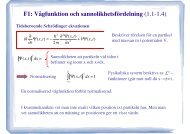Final Examination Paper for Electrodynamics-I [Solutions]
Final Examination Paper for Electrodynamics-I [Solutions]
Final Examination Paper for Electrodynamics-I [Solutions]
You also want an ePaper? Increase the reach of your titles
YUMPU automatically turns print PDFs into web optimized ePapers that Google loves.
where ∇ 2 F (x, x ′ ) = 0 within the volume V and F is chosen such that G satisfies<br />
specified boundary conditions on the boundary S of V . Now, in Green’s second<br />
identity, <br />
d<br />
V<br />
3 x ′ (ψ1∇ ′2<br />
ψ2 − ψ2∇ ′2<br />
ψ1) = ds<br />
S<br />
′ ∂ψ2 ∂ψ1<br />
(ψ1 − ψ2 ) ,<br />
∂n ′ ∂n ′<br />
choose ψ1(x ′ ) = φ(x ′ ) and ψ2(x ′ ) = G(x − x ′ ) to get the <strong>for</strong>mal solution to the<br />
Laplace equation,<br />
<br />
φ(x) =<br />
V<br />
d 3 x ′ ρ(x ′ )G(x − x ′ ) + 1<br />
4π<br />
<br />
S<br />
<br />
ds ′<br />
<br />
G(x − x ′ ) ∂φ<br />
∂n ′ (x′ ) − φ(x ′ ) ∂<br />
∂n ′ G(x − x′ <br />
) .<br />
For Dirichlet boundary conditions on φ, we are given φ(x ′ ) <strong>for</strong> all x ′ on the surface<br />
S. Then on G we need the Dirichlet boundary conditions<br />
leading to<br />
<br />
φ(x) =<br />
V<br />
GD(x − x ′ ) = 0, <strong>for</strong> all x ′ on S ,<br />
d 3 x ′ ρ(x ′ )GD(x − x ′ ) − 1<br />
<br />
ds<br />
4π S<br />
′<br />
<br />
φ(x ′ ) ∂<br />
∂n ′ GD(x − x ′ <br />
) .<br />
For Neumann boundary conditions on φ, we are given ∂φ<br />
∂n ′ (x ′ ) <strong>for</strong> all x ′ on S. However,<br />
we cannot simply impose ∂<br />
∂n ′ G(x − x ′ ) = 0 since this contradicts the defining<br />
equation <strong>for</strong> G. Then the simplest boundary condition is<br />
∂<br />
∂n ′ G(x − x′ ) = − 4π<br />
A , <strong>for</strong> all x′ on S ,<br />
where A is the total area of the boundary S. This leads to the solution<br />
<br />
φ(x) = 〈φ〉S + d 3 x ′ ρ(x ′ )GN(x − x ′ ) + 1<br />
<br />
4π<br />
ds ′<br />
<br />
GN(x − x ′ ) ∂φ<br />
∂n ′ (x′ <br />
)<br />
V<br />
where 〈φ〉S is average value of φ over the surface S.<br />
2. (a) Consider an electric dipole of moment p placed at the origin. Evaluate the<br />
electrostatic potential at a point x generated by this dipole.<br />
(b) Consider a macroscopic volume V within a polarized dielectric material containing<br />
free charges of density ρf(x ′ ) and a dipole moment density P (x ′ ). Compute<br />
the electric potential φ(x) due to free charges and dipoles within V. Express<br />
polarization charge density ρpol and the electric displacement vector D in<br />
terms of P .<br />
Solution (points: 13)<br />
a) A dipole is constructed from charges q and −q a distance y apart. In the setup<br />
given, the midpoint of y is the origin of the coordinate system. Then the potential<br />
at any point x is given by,<br />
Φ(x) =<br />
q<br />
|x − y/2| −<br />
q<br />
|x + y/2| .<br />
2<br />
S<br />
,


![Final Examination Paper for Electrodynamics-I [Solutions]](https://img.yumpu.com/21085948/2/500x640/final-examination-paper-for-electrodynamics-i-solutions.jpg)
